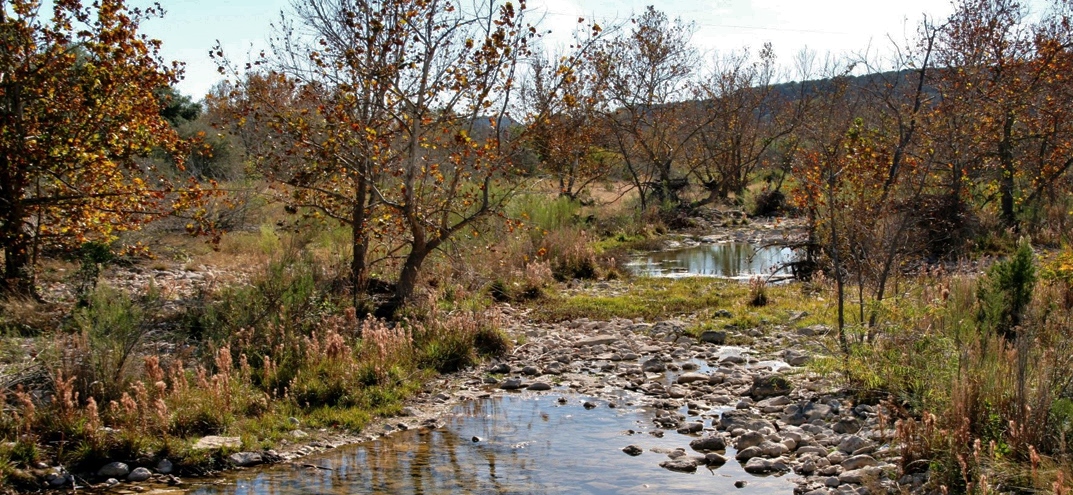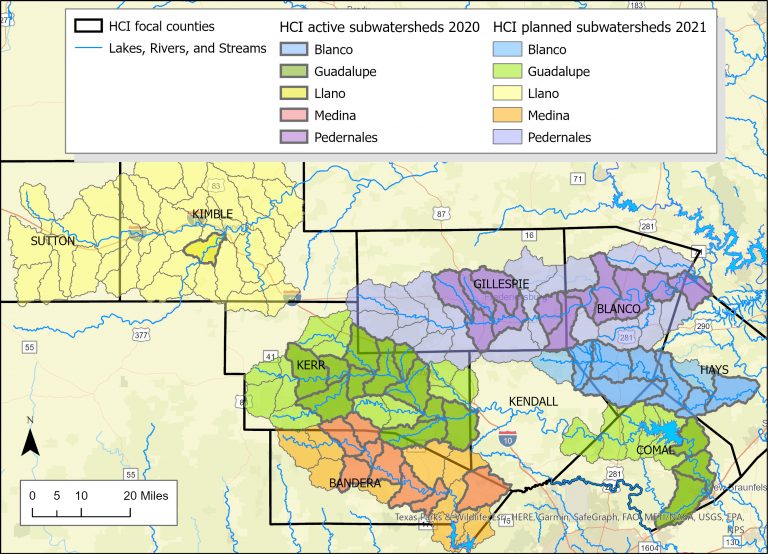Riparian Management

Riparian Management
An easy way to keep Hill Country streams clean and flowing is to use simple riparian management techniques. A riparian area is often described as the “river bank” but in reality it is much more. The riparian area is the interface between land and water along a body of water. It includes the vegetation, soils and features from the water’s edge across the flood plain to the upland area. Typically, the best approach for managing this system is to do nothing, observe and let nature do the work.
Where riparian areas have been disturbed from overgrazing, mechanical lawn mowing, excessive erosion or other alterations to the natural order, restoration MAY be necessary to re-create a healthy functioning system, resulting in more water and cleaner water. The value of riparian preservation/restoration work is immeasurable when you consider the quandary we face with dwindling water supplies throughout the Hill Country. Healthy riparian areas protect water supply in times of drought and slow water velocity in times of flood.
In a nutshell, dense vegetation (native trees, shrubs and grasses) and an active floodplain are necessary to slow water down (dissipate energy) and trap mobile sediment. These are the building blocks of riparian health. Interlaced roots and trapped sediment rich in water storing organic material help to stabilize banks and conserve floodwater. That water recharges groundwater resources and can return to the channel in the form of clean base flow.
The first step toward good riparian management is having an understanding of what a healthy riparian area looks like and how it functions in both drought and flood. On this page you’ll find important links and documents to help educate Hill Country landowners and citizens about proper riparian land management.
Arundo donax and the Healthy Creeks Initiative
Arundo donax, also referred to as Giant Reed or Carrizo Cane, is a non-native, invasive plant that can take over creeks and rivers. This invasive plant has the potential to significantly damage the health of Hill Country streams and rivers by worsening flooding, displacing native plants, destabilizing banks, contributing to erosion, degrading fish and wildlife habitat, and increasing wildfire risk. Click here to view an informational graphic on Arundo.
Since 2016, the Texas Parks & Wildlife Department (TPWD), Hill Country Alliance (HCA), City of Fredericksburg, and other organizations have partnered with volunteering landowners through the Healthy Creeks Initiative to control Arundo donax and enhance the creek-side (or riparian) habitat along Barons Creek, Town Creek, and other portions of the Pedernales River Basin primarily upstream of Johnson City. The Healthy Creeks Initiative focuses its efforts within rivers and creeks in the headwaters of the Blanco, Guadalupe, Llano, Medina, and Pedernales watersheds. The initiative focuses on improving riparian health by providing Arundo control at no cost to landowners.
Through the Healthy Creeks Initiative, TPWD partners with government entities, nonprofit organizations, volunteers, and hundreds of private landowners to implement large-scale management of Arundo on Hill Country rivers and streams. Since 2015, efforts have been highly successful (see project map) and continue to expand to new areas.
Click here to learn more about the Healthy Creeks Initiative.
Helpful Riparian Resources
 Tips & Tidbits for Hill Country Landowners: Grow Zones and Targeted Access Along Creeks & Rivers
Tips & Tidbits for Hill Country Landowners: Grow Zones and Targeted Access Along Creeks & Rivers
Across the Texas Hill Country, private landowners, businesses, housing developments and public parks are establishing “Grow Zones” along creeks and rivers to protect the land and water. Grow Zones are specific areas where disturbances, such as excessive mowing and foot traffic, are proactively restricted to allow native plants to thrive.
Click here to view and download a Tips and Tidbits for Hill Country Landowners PDF on Grow Zones
 Tips & Tidbits for Hill Country Landowners: Riparian Planting and Materials Resource Guide
Tips & Tidbits for Hill Country Landowners: Riparian Planting and Materials Resource Guide
Click here for a two-part guide to riparian planting! Section one provides an overview of the planting methods used along Hill Country creeks and rivers in what is referred to as the riparian zone. Key considerations, as well as a few appropriate riparian species, are listed for each planting technique. The second section is a resource guide on where to obtain native plant materials in Central Texas.
Grow Zones: Cultivating Texan Rivers and Creeksides in your own Backyard
Looking to improve the health and function of your creek or riverside? Watch this video with to learn about cultivating a riparian Grow Zone on your riverside property by exploring several examples of mixed use grow zones on the Blanco River.
Get to Know the Healthy Creeks Initiative
Learn about the importance of riparian systems, concerns around infestations of non-native Arundo (a.k.a. giant reed or river cane), and voluntary steps that hundreds of private landowners are taking to control Arundo in order to enhance the health and diversity of Hill Country creeks and rivers.
Riparian Stewardship in the Texas Hill Country: Strategies for Native Plant Restoration
Regardless of the season, it’s always a great time to consider what’s growing on your riverbank! Learn more about strategies for native plant restoration in riparian areas, where land and water meet. Filmed on location at the YMCA’s Roberts Ranch near Comfort, TX, this video features Steve Nelle of NRCS (retired), Ryan McGillicuddy of Texas Parks and Wildlife, and HCA’s Land Program Manager, Daniel Oppenheimer.
Pull. Kill. Plant: Arundo Control & Riparian Restoration in the Nueces Basin
The Giant Reed (Arundo donax) is a well known invasive plant on Texas riversides. Since 2010, groups like the Nueces River Authority are working to pull and kill the invasive plant to make way for planting native riparian plants on riverbanks along the Nueces and its tributaries. The project is a great example of successful management in partnership with riverside landowners. Click here to learn more.
Riparian Recovery in the Blanco River
The Hill Country is no stranger to catastrophic flooding, as evidenced by the 2015 Memorial Day Flood. While the region does not always experience severe flooding, we often go back and forth in a cycle between extreme flooding and drought. As our region grows and landscapes are developed for housing and commercial purposes, it is crucial that we take care to preserve our riparian areas. Healthy riparian areas serve as a buffer – they slow floodwaters, stabilize banks, increase recharge into our groundwater resources, and even help to filter water as it rushes by. By following the processes recommended in this videos, landowners can take proactive steps to preserve their riverfront property when severe weather comes our way.
Austin Watershed Creekside Restoration Guide
Click and scroll through the interactive Story Map below to learn more about creekside restoration. From developing a plan for restoration to adopting a park or creek, this handy guide is full of stewardship information, courtesy of the City of Austin Watershed Protection Department.
Your Remarkable Riparian Field Guide
Click here to view Your Remarkable Riparian Field Guide
Author: Sky Lewey
Supporters: The Meadows Foundation, The Dixion Water Foundation, Stewards of the Nueces, Texas Wildlife Association Foundation, and Texas Coalition-Grazing Lands Conservation Initiative, United states Department of Agriculture-Natural Resources Conservation Service.
Description: Field guide to riparian plants within the Nueces River Basin.
Managing Riparian Areas
Click here to view Managing Riparian Areas
Author: Steve Nelle
Description: As Texas’ most acclaimed riparian educator, Steve Nelle has created here a thorough, well-organized, and wise guide for riparian stewards everywhere. He has a great deal of knowledge to impart and has done it wonderfully within these pages— almost as good as a walk along the bank of a special stream with Steve as our personal guide.
Recent Riparian News
Why are riparian areas important?
Most Texans recognize that water bodies provide essential benefits such as drinking water, recreation, irrigation water and ecosystem benefits, but do you know why the areas of land surrounding those water sources are critically important? “Riparian areas are...
USDA investing $197 million in partner-driven, locally led conservation
The U.S. Department of Agriculture (USDA) announced it is awarding $197 million for 41 locally led conservation projects through the Regional Conservation Partnership Program (RCPP). RCPP is a partner-driven program that leverages partner resources to advance...
Editor’s Note: Preserved Paradise
I’ve lived in the Hill Country for five years now, yet I’m still finding new reasons to admire its grandeur on a regular basis. I love that my kids get to grow up in such a beautiful, wild landscape, and I hope their kids will have the same opportunity. As Central...
Texas climatologists warn of potential for prolonged drought
While much of Texas is mired in drought conditions as warmer months are on the horizon, state climatologists are looking closely a t future rainfall predictions to gauge just how long dry conditions will last. So far, they say, the outlook isn’t good. Read more...





